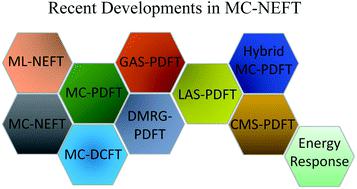当前位置:
X-MOL 学术
›
Chem. Sci.
›
论文详情
Our official English website, www.x-mol.net, welcomes your
feedback! (Note: you will need to create a separate account there.)
Electronic structure of strongly correlated systems: recent developments in multiconfiguration pair-density functional theory and multiconfiguration nonclassical-energy functional theory
Chemical Science ( IF 7.6 ) Pub Date : 2022-06-07 , DOI: 10.1039/d2sc01022d Chen Zhou 1 , Matthew R Hermes 2 , Dihua Wu 1 , Jie J Bao 1 , Riddhish Pandharkar 2, 3 , Daniel S King 2 , Dayou Zhang 1 , Thais R Scott 2 , Aleksandr O Lykhin 2 , Laura Gagliardi 2, 3 , Donald G Truhlar 1
Chemical Science ( IF 7.6 ) Pub Date : 2022-06-07 , DOI: 10.1039/d2sc01022d Chen Zhou 1 , Matthew R Hermes 2 , Dihua Wu 1 , Jie J Bao 1 , Riddhish Pandharkar 2, 3 , Daniel S King 2 , Dayou Zhang 1 , Thais R Scott 2 , Aleksandr O Lykhin 2 , Laura Gagliardi 2, 3 , Donald G Truhlar 1
Affiliation

|
Strong electron correlation plays an important role in transition-metal and heavy-metal chemistry, magnetic molecules, bond breaking, biradicals, excited states, and many functional materials, but it provides a significant challenge for modern electronic structure theory. The treatment of strongly correlated systems usually requires a multireference method to adequately describe spin densities and near-degeneracy correlation. However, quantitative computation of dynamic correlation with multireference wave functions is often difficult or impractical. Multiconfiguration pair-density functional theory (MC-PDFT) provides a way to blend multiconfiguration wave function theory and density functional theory to quantitatively treat both near-degeneracy correlation and dynamic correlation in strongly correlated systems; it is more affordable than multireference perturbation theory, multireference configuration interaction, or multireference coupled cluster theory and more accurate for many properties than Kohn–Sham density functional theory. This perspective article provides a brief introduction to strongly correlated systems and previously reviewed progress on MC-PDFT followed by a discussion of several recent developments and applications of MC-PDFT and related methods, including localized-active-space MC-PDFT, generalized active-space MC-PDFT, density-matrix-renormalization-group MC-PDFT, hybrid MC-PDFT, multistate MC-PDFT, spin–orbit coupling, analytic gradients, and dipole moments. We also review the more recently introduced multiconfiguration nonclassical-energy functional theory (MC-NEFT), which is like MC-PDFT but allows for other ingredients in the nonclassical-energy functional. We discuss two new kinds of MC-NEFT methods, namely multiconfiguration density coherence functional theory and machine-learned functionals.
中文翻译:

强相关系统的电子结构:多构型对密度泛函理论和多构型非经典能量泛函理论的最新进展
强电子关联在过渡金属和重金属化学、磁性分子、键断裂、双自由基、激发态和许多功能材料中发挥着重要作用,但它对现代电子结构理论提出了重大挑战。强相关系统的处理通常需要多参考方法来充分描述自旋密度和近简并相关。然而,与多参考波函数的动态相关性的定量计算通常是困难的或不切实际的。多配置对密度泛函理论(MC-PDFT)提供了一种融合多配置波函数理论和密度泛函理论的方法,以定量处理强相关系统中的近简并相关和动态相关;它比多参考扰动理论、多参考配置交互或多参考耦合集群理论更实惠,并且比 Kohn-Sham 密度泛函理论在许多属性上更准确。这篇透视文章简要介绍了强相关系统和之前回顾的 MC-PDFT 进展,然后讨论了 MC-PDFT 和相关方法的一些最新发展和应用,包括局部主动空间 MC-PDFT、广义主动-空间 MC-PDFT、密度矩阵重整化群 MC-PDFT、混合 MC-PDFT、多态 MC-PDFT、自旋轨道耦合、解析梯度和偶极矩。我们还回顾了最近引入的多配置非经典能量泛函理论(MC-NEFT),这类似于 MC-PDFT,但允许非经典能量泛函中的其他成分。我们讨论了两种新的 MC-NEFT 方法,即多配置密度相干泛函理论和机器学习泛函。
更新日期:2022-06-07
中文翻译:

强相关系统的电子结构:多构型对密度泛函理论和多构型非经典能量泛函理论的最新进展
强电子关联在过渡金属和重金属化学、磁性分子、键断裂、双自由基、激发态和许多功能材料中发挥着重要作用,但它对现代电子结构理论提出了重大挑战。强相关系统的处理通常需要多参考方法来充分描述自旋密度和近简并相关。然而,与多参考波函数的动态相关性的定量计算通常是困难的或不切实际的。多配置对密度泛函理论(MC-PDFT)提供了一种融合多配置波函数理论和密度泛函理论的方法,以定量处理强相关系统中的近简并相关和动态相关;它比多参考扰动理论、多参考配置交互或多参考耦合集群理论更实惠,并且比 Kohn-Sham 密度泛函理论在许多属性上更准确。这篇透视文章简要介绍了强相关系统和之前回顾的 MC-PDFT 进展,然后讨论了 MC-PDFT 和相关方法的一些最新发展和应用,包括局部主动空间 MC-PDFT、广义主动-空间 MC-PDFT、密度矩阵重整化群 MC-PDFT、混合 MC-PDFT、多态 MC-PDFT、自旋轨道耦合、解析梯度和偶极矩。我们还回顾了最近引入的多配置非经典能量泛函理论(MC-NEFT),这类似于 MC-PDFT,但允许非经典能量泛函中的其他成分。我们讨论了两种新的 MC-NEFT 方法,即多配置密度相干泛函理论和机器学习泛函。











































 京公网安备 11010802027423号
京公网安备 11010802027423号